Fujian Tulou, Hakka Earth Buildings
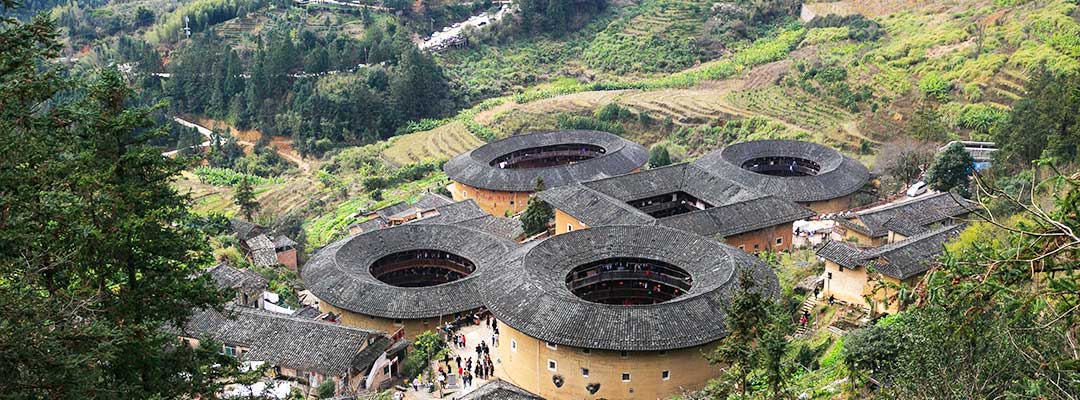
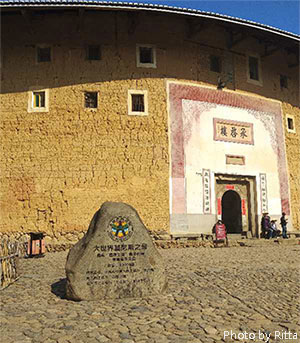
The Fujian Hakka Earth Buildings are a design of building where people belonging to the same clan live together, with the added function of defense. Yongding County and Nanjing County in Fujian Province have the greatest concentration of Fujian Hakka Earth Buildings, which can also be seen in Pinghe, Zhangpu, Yunxiao, Hua’an, Zhao’an and other regions in the Minnan area (the southern part of Fujian province).
Fujian Tulou were built in the Song and Yuan Dynasties and have a history of more than 1,000 years. This style of building was in its heyday in the late Ming Dynasty, the early Qing Dynasty and the era of the Republic of China, and has been preserved until now. The buildings are over two-stories tall, consisting of thick walls constructed of rammed-earth between outer panels. The main architecture materials were earth, wood, stones and bamboo. It was a mixture of clay and sandy soil in a specific proportion.
In 1995, as the representative of China’s southern and northern circular architecture, architectural models of Fujian Hakka Earth Building and Temple of Heaven were displayed in the World Architecture Exhibition of America in Los Angeles. It caused a sensation and was honored as “the Oriental Pearl of Architecture”. In 2008, the Fujian Hakka Earth Building was officially added to the World Heritage List.
Formation of Fujian Hakka Earth Building
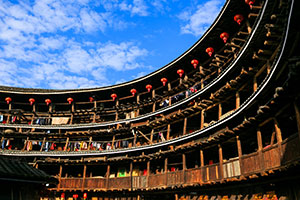
The formation of the Fujian Hakka Earth Building is relevant to several famous great migrations of the Han people in central China in history. In the Yongjia period of the Western Tsin Dynasty (the 4th century A.D.), with frequent wars and numerous natural disasters, residents from central China migrated to the south on a large scale, which marked the beginning of the continuous migration of the Han people from central China to Fujian province.
The immigrants from central China integrated with the local people in Minnan (southern Fujian) and formed the Hoklo people who speak Hokkien. After migration, the newcomers entered into the mountain areas of western Fujian through Ganzhou, Jiangxi Province and formed another important patriarchal clan in Fujian – the Hakka people who speak the Hakka dialect.
Fujian Hakka Earth Buildings can be found in the mountainous areas of southwestern Fujian where the topography is precipitous and at the time the population was sparse, with wild beasts and rampant bandits frequently attacking. Living together with the clan is not only a firmly established requirement of Confucian tradition in central China, but also a practical need to consolidate power to defend themselves against enemies. Making full use of the advantage of terrain, Fujian Hakka Earth Buildings enjoy a rational layout and absorb the Fengshui concept of Chinese traditional architectural design, satisfying the requirements of living together with the clan as well as the need for defense.
At first, the local people followed the old earth construction techniques and took the local bamboo, wood, mud and stones as their raw materials. Gradually the primary simple log cabins and mud houses evolved into earth buildings with mud walls and tile roofs. Later, in order to satisfy the need to live together with the clan, the buildings developed into large multi-story earth buildings with complex organization.
As well as defending against enemies, the earth building also has the function of fire resistance, earthquake resistance, beast resistance, adequate ventilation and good lighting. As well as this, the building is cool in summer and warm in winter.
Traditional Culture
Fujian Hakka people take pride in their Fujian Hakka Earth Buildings, which are considered to be the treasure of Fujian residences. Reflecting the humanity factor, Fujian Hakka Earth Buildings show the combination of heaven, earth and humanity. A design where dozens of households and hundreds of people live together in the one building reflects the Hakka people’s family tradition of people of the same clan living together in harmony. Therefore, the history of an earth building is also the history of the clan.
Architectural Characteristics
Appearance
The Fujian Hakka Earth Buildings are a collective construction based on earth walls. They can be divided into two categories – square buildings and circular buildings. Originally, the earth buildings were square. However, as a square earth building has four sides, the four corners of the building are relatively dark, resulting in differences in ventilation and lighting. Thus, the Hakka people developed circular earth buildings which have better ventilation and lighting. The circular earth buildings are the most eye-catching among the existing earth buildings. The local people call it Yuanlou or Yuanzhai.
Functions
The most prominent feature of the Fujian Hakka Earth Building is its large size. The most common circular earth buildings are about 50m in diameter and three to four stories in height, with one hundred rooms which can accommodate thirty to forty families, amounting to about two to three hundred people. However, a really large-scale circular building can have a diameter of up to 70 to 80 meters, with five to six stories and four to five hundred rooms which can accommodate seven to eight hundred people. Earth buildings are suitable for extended families to live together and can serve as war defense as well. The descendants of the same ancestor within an earth building form an independent society with a common destiny.
Materials
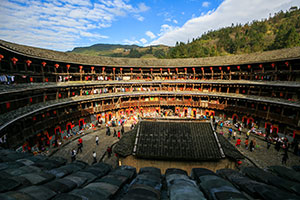
The walls of Fujian Hakka Earth Buildings are thicker on the bottom and thinner at the top, with the thickest part being up to 1.5 meters. When building the wall, the Hakkas dug a substantial, deep trench at the footing of wall, and filled it with large rocks to consolidate the foundation. Then stones and mortar were used to build the wall base, followed by ramming earth sandwiched between panels to create the wall. The key step is to add glutinous rice and brown sugar to increase the viscosity of the rammed earth. When ramming, the Hakkas put branches of cedar wood and bamboo strips into the middle of the earth building as “wall bones” to reinforce its tension. After being repeatedly consolidated, the constructed earth wall was as strong as reinforced concrete. Finally, the surface of the wall was plastered with lime which is weatherproof and has anti-erosion properties. Thus, it is extremely solid, with great wind-resistance and anti-seismic ability.
Layout
The circular earth building is the most distinctive building style among local earth building clusters. Encompassing a central point, the building extends right out to the edge. The center of the building is reserved for the family temple yard and between the inner and outer circle are the ancestor hall and corridor, and residential rooms. All of the rooms in the earth building are the same size, which is about ten square meters, and the households in the building use public stairs.
Distributions
Fujian Hakka Earth Buildings are mainly distributed in three areas, Yongding Hakka Earth Building area, Nanjing Hekeng Earth Building area and Huaan Earth Building area.
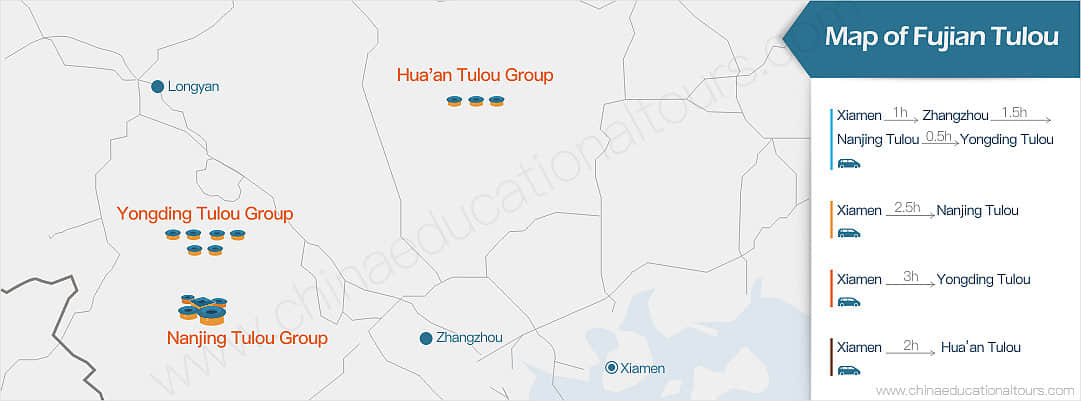
Yongding Hakka Earth Building Area: The Yongding Hakka Earth Building Complex is home to more than 20,000 earth buildings among which nearly 5,000 are large scale earth buildings of more than 3 stories in height. The Yongding Hakka Earth Buildings are an outstanding representative residence of Hakka people. It consists of three earth building clusters, Gaobei Earth Building Cluster (the largest and most classical one), Hongkeng Earth Building Cluster (with a combination of Chinese and Western architectural styles) and Chuxi Earth Building Cluster (the shooting place of the TV series South of the Ocean).
Nanjing Hekeng Earth Building Area: The Nanjing Hekeng Earth Building Complex is made up of three earth building clusters, Tianluokeng, Yunshuiyao and Hekeng Earth Building Clusters. Tianluokeng Earth Building is the representative building of Fujian Hakka Earth Building and is also the most delicate cluster among earth buildings. It is an iconic landscape among the world heritage.
Yunshuiyao Earth Building Cluster is famous for the movie The Knot and thus it is honored as “the most romantic earth building complex”.
Hekeng Earth Building Cluster is the shooting place of the TV show Dad, Where Are We Going, which draws many tourists there.
Hua'an Earth Building Area: This is considered to be the most exquisitely built earth building. Eryi Earth Building is the most representative one within the complex, which is the perfect combination of Hakka Earth Building and Minnan Earth Building. Less commercialized, this area reflects the original lifestyle of the locals.

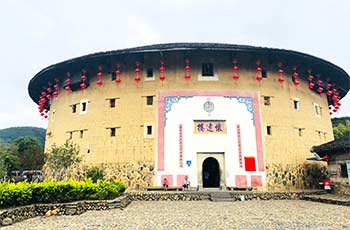 Yongding Tulou
Yongding Tulou 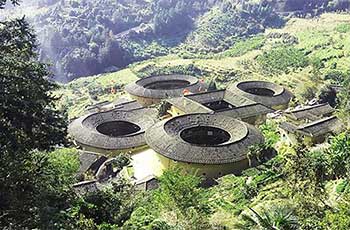 Nanjing Tulou
Nanjing Tulou 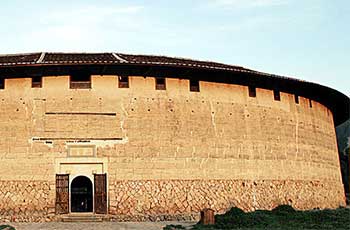 Hua'an Tulou
Hua'an Tulou 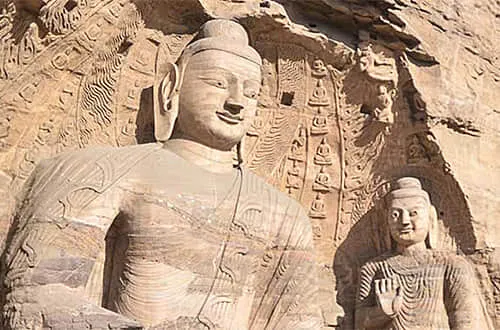 Top World Heritage Sites in China
Top World Heritage Sites in China